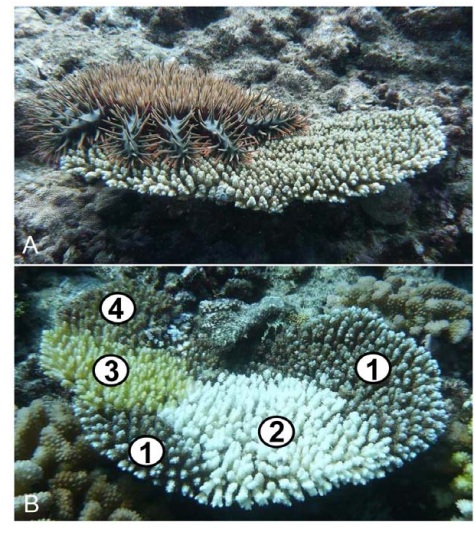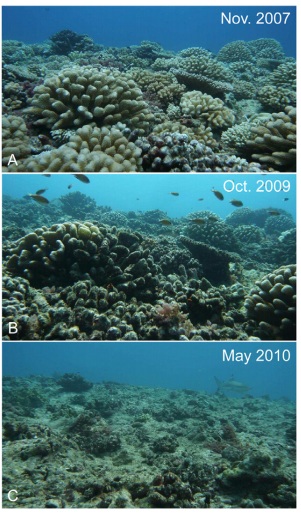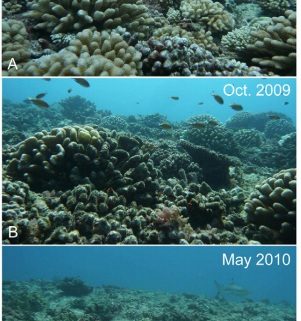Crown of thorns starfish: a threat to coral reefs
by Brittany Bartlett, RJD intern
Coral reefs are vulnerable species, highly susceptible to a wide range of disturbances. And, episodic outbreaks of the Crown-of Thorns coral killing sea star (Acanthaster planci) are one of these dangerous disturbances. These sea star outbreaks threaten the well being of our ocean, as they feed on and deplete reef building coral, altering the current composition of the marine ecosystem.
Until recently the causes and spatio-temporal dynamics of these sea star outbreaks have not been well understood. A recent study by Mohsen Kayal et al (2012) in the south Pacific, however, has been able to examine and describe the entire development and process of the outbreak, as well as the consequences that these epidemics have on benthic communities and resident coral feeding fish.
Two complementary sampling approaches were performed during this study to acquire observations. One sampling approach observed sea star aggregation from 2003/2005 until 2010. The distribution and densities of the seastars were tracked. The other sample was an irregular survey of various significant functional groups within the benthic and fish communities at designated reference point on the reef.

Figure 1 from Kayal et al 2012. “Photographs illustrating the outbreaking seastar Acanthaster and its feeding-scars as found on colonies preyed upon. (A) An Acanthaster planci observed on a living tabular coral from the genus Acropora. (B) A partially-killed coral from the genus Acropora bearing feeding-scars left by successive predation events by Acanthaster: 1) live portion of the colony bearing the pigmented coral tissue, 2) freshly killed portion of the colony deprived of its pigmeneted living tissue (3 weeks post-predation)
Studies observed that sea star outbreaks led to decrease in coral reef coverage from approximately 40% in 2005 to as low as 5% in 2010. However, each species of coral was not equally impacted, as the sea star seemed to favor certain species. The Crown-of Thorns sea star was most drawn to a branching species of coral, Acropora, followed by a sub branching species, Pocipora, and so on. This resulted in a sequential and ordered eradication of coral reef species.
The movement and migration of the sea stars appears to be motivated by hunger. Densities began in restricted areas at the base of the reef. As prey became less available (due to an increase in predators), the species began to migrate toward the unaffected reef in shallower locations. Thus, studies portray the crown of thorn starfish outbreaks as a semi controlled, slow paced, subtle biological disturbance.

Figure 2 from Kayal et al 2012. “A portion of Morrean outer-reef (6 m-depth on the site Vaipahu) is shown through time.” (A) Corals dominate the healthy reef (coral cover >40%). (B) Algae have colonized dead coral skeletons following severe predation by the seastar Acanthaster (~10% coral cover). (C) Mostly dead and weakened coral skeletons were swept away by a cyclone occurring at the end of the seastar outbreak (Lison de Lom et al. unpublished data) and colonizing algae once again dominate the devastated reef (~5% coral cover).
As the once coral dominated ecosystem becomes depleted, ecosystem characteristics begin to change. Scientists noted an increase in benthic algae, a loss of coral feeding assemblages, and an overall collapse of reef structural complexity and decline in biodiversity and productivity. Crown-of-Thorn sea star outbreaks have the potential to be very detrimental to the well being of the marine ecosystem.
Enhanced understanding through this study regarding the patterns of these outbreaks, can improve management and monitoring efforts for coral reef ecosystems. Improved monitoring will allow for quicker outbreak detection, and thus an improvement in efforts to control the epidemic. Adequate research and understanding is the first step in successfully protecting our environment.
REFERENCES
Kayal M, Vercelloni J, Lison de Loma T, Bosserelle P, Chancerelle Y, et al (2012) Predator Crown-of Thorns Starfish (Acanthaster planci) Outbreak, Mass of Mortality of Corals, and Cascading Effects on Reef Fish and Benthic Communities. PLoS ONE 7(10) : e47363. doi:10.1371/journal.pone.0047363




Awesome information and truly amazing pictures, I would more than appreciate to read more about whatever you can bring to the table.